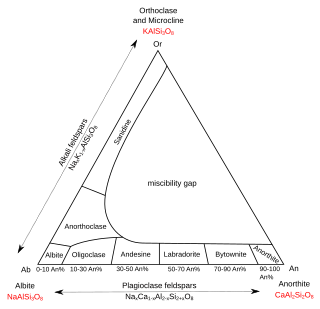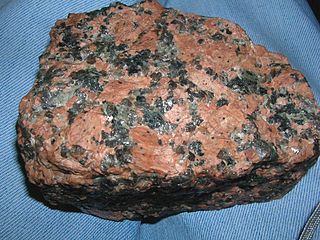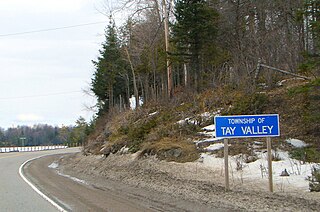
Granite is a common type of felsic intrusive igneous rock that is granular and phaneritic in texture. Granites can be predominantly white, pink, or gray in color, depending on their mineralogy. The word "granite" comes from the Latin granum, a grain, in reference to the coarse-grained structure of such a holocrystalline rock. Strictly speaking, granite is an igneous rock with between 20% and 60% quartz by volume, and at least 35% of the total feldspar consisting of alkali feldspar, although commonly the term "granite" is used to refer to a wider range of coarse-grained igneous rocks containing quartz and feldspar.

Microcline (KAlSi3O8) is an important igneous rock-forming tectosilicate mineral. It is a potassium-rich alkali feldspar. Microcline typically contains minor amounts of sodium. It is common in granite and pegmatites. Microcline forms during slow cooling of orthoclase; it is more stable at lower temperatures than orthoclase. Sanidine is a polymorph of alkali feldspar stable at yet higher temperature. Microcline may be clear, white, pale-yellow, brick-red, or green; it is generally characterized by cross-hatch twinning that forms as a result of the transformation of monoclinic orthoclase into triclinic microcline.
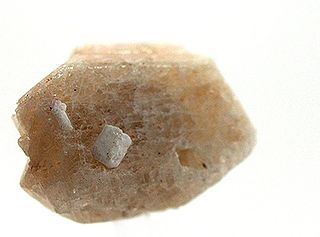
The mineral anorthoclase ((Na,K)AlSi3O8) is a crystalline solid solution in the alkali feldspar series, in which the sodium-aluminium silicate member exists in larger proportion. It typically consists of between 10 and 36 percent of KAlSi3O8 and between 64 and 90 percent of NaAlSi3O8.

Tonalite is an igneous, plutonic (intrusive) rock, of felsic composition, with phaneritic texture. Feldspar is present as plagioclase with 10% or less alkali feldspar. Quartz is present as more than 20% of the rock. Amphiboles and pyroxenes are common accessory minerals.

Nepheline syenite is a holocrystalline plutonic rock that consists largely of nepheline and alkali feldspar. The rocks are mostly pale colored, grey or pink, and in general appearance they are not unlike granites, but dark green varieties are also known. Phonolite is the fine-grained extrusive equivalent.
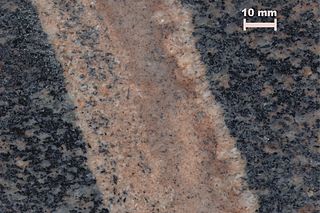
Aplite is an intrusive igneous rock in which the mineral composition is the same as granite, but in which the grains are much finer, under 1 mm across. Quartz and feldspar are the dominant minerals. The term 'aplite' or 'aplitic' is often used as a textural term to describe veins of quartz and feldspar with a fine to medium-grain "sugary" texture. Aplites are usually very fine-grained, white, grey or pinkish, and their constituents are visible only with the help of a magnifying lens. Dykes and veins of aplite are commonly observed traversing granitic bodies; they occur also, though less frequently, in syenites, diorites, quartz-diabases and gabbros.

Perthite is used to describe an intergrowth of two feldspars: a host grain of potassium-rich alkali feldspar (near K-feldspar, KAlSi3O8, in composition) includes exsolved lamellae or irregular intergrowths of sodic alkali feldspar (near albite, NaAlSi3O8, in composition). Typically the host grain is orthoclase or microcline, and the lamellae are albite. If sodic feldspar is the dominant phase, the result is an antiperthite and where the feldspars are in roughly equal proportions the result is a mesoperthite.
Essexite, also called nepheline monzogabbro, is a dark gray or black holocrystalline plutonic igneous rock. Its name is derived from the type locality in Essex County, Massachusetts, in the United States.

Granophyre is a subvolcanic rock that contains quartz and alkali feldspar in characteristic angular intergrowths such as those in the accompanying image.

A QAPF diagram is a double ternary diagram which is used to classify igneous rocks based on mineralogic composition. The acronym, QAPF, stands for "Quartz, Alkali feldspar, Plagioclase, Feldspathoid (Foid)". These are the mineral groups used for classification in QAPF diagram. Q, A, P and F percentages are normalized.
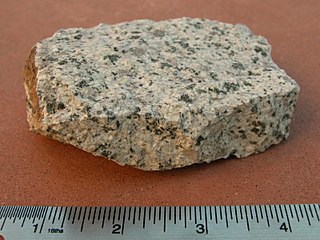
Monzonite is an igneous intrusive rock. It is composed of approximately equal amounts of plagioclase and alkali feldspar, with less than 5% quartz by weight. It may contain minor amounts of hornblende, biotite and other minerals. If quartz constitutes greater than 5%, the rock is termed a quartz monzonite.

Myrmekite describes a vermicular, or wormy, intergrowth of quartz in plagioclase. The intergrowths are microscopic in scale, typically with maximum dimensions less than 1 millimeter. The plagioclase is sodium-rich, usually albite or oligoclase. These quartz-plagioclase intergrowths are associated with and commonly in contact with potassium feldspar. Myrmekite is formed under metasomatic conditions, usually in conjunction with tectonic deformations. It has to be clearly separated from micrographic and granophyric intergrowths, which are magmatic.
In petrology, micrographic texture is a fine-grained intergrowth of quartz and alkali feldspar, interpreted as the last product of crystallization in some igneous rocks which contain high or moderately high percentages of silica. Micropegmatite is an outmoded terminology for micrographic texture.
In subsolvus or two feldspar granites crystallisation occurs at high water pressures resulting in the formation of two types of feldspar as opposed to hypersolvus granites in which crystallization at relatively low water pressures results in the formation of a single feldspar variety.
Quoting Tuttle and Bowen in 1958 : ″A classification of salic rocks based on the nature of the alkali feldspar is proposed. The classification has two major divisions: (1) subsolidus, and (2) hypersolvus, depending on the whereabouts of the soda feldspar. In the hypersolvus rocks all the soda feldspar is or was in solid solution in the potash feldspar whereas in the subsolvus rocks the plagioclase is present as discrete grains. The two major divisions are further subdivided according to the nature of the alkali feldspar modification.″ Note that here the word "subsolidus" unfortunately looks like a misprint and probably has to be replaced by "subsolvus".
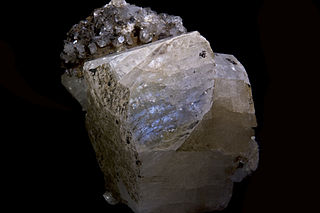
Moonstone is a sodium potassium aluminium silicate ((Na,K)AlSi3O8) of the feldspar group that displays a pearly and opalescent schiller. An alternative name is hecatolite.
Alkali basalt or alkali olivine basalt is a fine-grained, dark-coloured, volcanic rock characterized by phenocrysts of olivine, titanium-rich augite, plagioclase feldspar and iron oxides. For similar SiO2 concentrations, alkali basalts have a higher content of the alkalis, Na2O and K2O, than other basalt types such as tholeiites. They are also characterized by the development of modal nepheline in their groundmass (visible at highest magnification on a petrographic microscope) and normative nepheline in their CIPW norms. Alkali basalts are typically found on updomed and rifted continental crust, and on oceanic islands such as Hawaii, Madeira and Ascension Island.
Trachybasalt is a volcanic rock with a composition between trachyte and basalt. Minerals in trachybasalt include alkali feldspar, calcic plagioclase, olivine, clinopyroxene and likely very small amounts of leucite or analcime. Trachybasalt is a basalt with high alkali content (5 to 7% Na2O + K2O, see TAS diagram).
